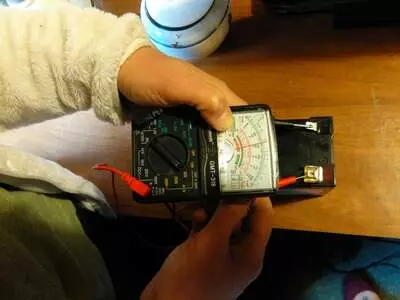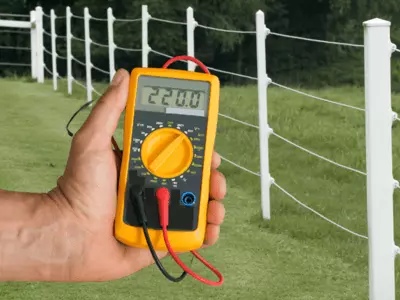Unfortunately, things happen, and your pet’s underground fence system may begin to have issues that need to be addressed.
If you suspect there is a break in your underground fence’s loop, a multimeter is a great tool that can help with this issue and can help determine if there is, in fact, a break.
You will need to connect the metal legs of the multimeter to the ends of your wires, but if the multimeter beeps, you have no break and the problem is elsewhere.
In this article, we will cover the basics of testing dog fence with multimeter tools and explore other needed information to complete the process.
What is a Multimeter?

A digital multimeter is a tool that can be used to measure a number of different electrical values.
They are typically able to measure voltage, current, and resistance, but more expensive models can also be purchased that have different capabilities.
All multimeters look a little bit different, but in general, they all have the same functions and abilities.
Where do I Buy a Multimeter?

Most basic multimeters can be found in hardware stores or online.
Depending on what you are looking for in your basic multimeter, you can expect to pay between $10 and $40 for one.
You can purchase basic models online at:
You can also stop by your local hardware store if you’d rather shop in person.
How to Test an Underground Dog Fence Using a Multimeter

There are a couple of different methods to find out if there is a break in your underground pet containment system.
In this section, we will go over all of these methods.
Using the Continuity Function
First, you will need to set your multimeter to the continuity setting. This setting should look like a speaker.
Next, you will connect the end of the metal legs of the multimeter to the twisted wire ends of your underground fence system.
At this point, listen for your multimeter to beep.
If the multimeter beeps, then your fence is continuous, and there is no break in the wire.
However, if the multimeter does not beep, then a break in your wire is likely.
Using Ohms
Again, we will begin by setting the meter to test continuity.
This time, we will also set it to read ohms, which is a symbol that looks like an upside-down letter “u” or a horseshoe.
Disconnect the wire from your base unit, and touch one of your terminals to one end, and the other terminal to the other end.
If the measurement on your screen is a number or a non-numerical unit, then your fence is continuous.
If no reading comes on the screen at all, then there is likely a break in the wire somewhere.
To go a step further, set your multimeter to VAC (Volts – Alternating Current) at 10 or 50 for fences that plug into your home’s power, or VDC (Volts – Direct Current) at 10 or 50 for fences that use battery power.
Then you will turn the fence on.
Touch one terminal to the exposed screw on one end of the wire, and the other terminal to the other end of the wire.
A properly functioning fence should read about 110 volts for plug-in systems and 12 volts for battery-operated systems.
Other Methods
There are also plenty of other methods to test for breaks in your underground fence without a multimeter.
These methods use a whole host of tools to help you to discover if your fence may have a break in it.
Stop by our guide, How to Find a Break in an Invisible Fence, for 3 methods you can use to test your fence without a multimeter!
There is a Break in My Fence – Now What?

Once you locate the break in the fence, it’s time to repair it.
In order to repair a break in an underground fence, you need to purchase an underground wire splicing kit.
- Carefully dig up the buried wire. Use caution and proceed gently and with care as digging can further damage the wire.
- Remove any protective coating from the ends of the two pieces of exposed wire.
- Reconnect the wires.
- Use one of the caps from your splicing kit and some waterproof gel to seal the ends of the wire together.
- The sealed wire then needs to be placed in the larger shell before reburying the wire.
- Repeat the testing steps to make sure you have corrected the issue before burying the wire once more.
If the wire is still not reading as continuous, even after repairs, then there may be a different break elsewhere.
The video below walks you through how to find a break:
There is No Break in My Fence, but it Still isn’t Working Properly

Sometimes, the cause of your issues with your underground fence is not a break in the fence, but something else.
If this is the case, it’s best to identify the issue at hand and then work to repair the problem.
Some other reasons that your fence may not be working properly are:
- Your E-Collar running out of battery
- Your E-Collar not being properly fitted to your pet
- Your settings on your system need to be adjusted
- There is an issue with your transmitter
- There is another installation issue
If there is another installation issue, our guide, Do it Yourself Invisible Fence, will help you make sure your fence is properly installed.
Any of these issues could cause your invisible dog fence not to work in the way it is intended.
Read our related article: How to Test an Electric Dog Fence. We cover wireless fence issues and solutions in this guide!
How to Test an Electric Fence with a Multimeter

In general, electric fences are not used to contain dogs and cats.
A multimeter can be used to test electric fences, but depending on how high the voltage is, you may need a specified electric fence tester to read the electricity output.
The process of testing these types of fences is similar to the testing of an underground fence.
The main difference is the considerably higher voltage expected from an electric fence, which is generally used to contain cattle.
Conclusion
Overall, testing an underground fence with a multimeter is an affordable and efficient way to ensure that there is no break in your system.
If there is a break in your system, you can then address your problem, and keep your pet safe in their yard.


